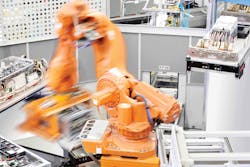Exploring Technology in the Food and Beverage Industry
With an anticipated global population increase and consumer preferences changing, food and beverage manufacturers must prepare now to ensure that they can meet demand. As a result, many manufacturers are turning to new technology to help them keep up. Here, Darcy Simonis, industry network leader for food and beverage at ABB, discusses the technology being used and the impact it is having on the industry.
There are many factors affecting the way food and beverage manufacturers handle their processes. Whether it’s the need for more efficient processing, the growing population or consumer preferences and attitudes constantly changing, food and beverage manufacturers must ensure that they can stay ahead. For example, food and lifestyle trends like veganism and plant-based food have taken the industry by storm. In fact, it was reported that there were over 600,000 vegans in the UK in 2018. This demonstrates why it’s essential for manufacturers to be prepared to adapt.
Food Through AR
For many, Augmented Reality (AR) is a normal part of everyday life. Since the boom of Snapchat filters and lenses, AR has become extremely popular and is now more commercially accessible than ever. With the AR market in Europe estimated to hit twelve billion dollars by 2024, industries are finding many applications to integrate this cutting-edge technology into daily practice—and the food and beverage industry is no different.
Staff working in a food and beverage facility can be trained through virtual instructions and scenarios, where it is possible to virtually visualize working and operating in the facility. This method of training could enable a more productive workforce to be trained at a quicker rate, compared to traditional and manual training.
AR can also enhance the consumer experience. Some manufacturers have designed products that have labels displaying nutritional or recipe information when AR is used. However, some suppliers are taking this one step further. A New York bakery, for instance, uses AR to display a 3D view of their products for customers to view before they place an order. Using AR in ways like this could increase sales as it means the customer can see the food or finished product before they commit to purchasing.
3D Printing Food
Another technology that’s being increasingly used in the food and beverage industry is 3D printing. Currently, 3D printing technology is being applied to industries such as automotive, aerospace and packaging, but it is now making its way into the food and beverage sector. In fact, it is predicted that by 2020, the global revenue for the 3D printing market will reach $21 billion.
One German company is using 3D printing to create 3D printed jelly meals for elderly care home residents that may have difficulty chewing or swallowing solid foods. As the potential uses of 3D printing are developed, the benefits that this technology can offer are becoming further understood. 3D printing food can produce precise results and save time and effort.
While 3D printing has the potential to provide innovative food to the growing population much faster compared to traditional methods of manufacturing, it also provides options for the industry to be more environmentally sustainable. 3D printing only uses the required amount of raw materials to make a finished product and the hydrocolloid cartridges that are used in 3D printers form a gel when mixed with water and leave minimal waste.
Blockchain technology
Consumer attitudes toward food have also changed. Whether it’s ensuring that produce is grown sustainably, plastic waste is kept to a minimum or even eliminated altogether, consumers now want to know every detail about the product they’re buying—and blockchain technology can provide just that.
Through blockchain, consumers can verify the history, origin, and quality of a product. Blockchain is benefitting the industry as it builds trust between the supplier, manufacturer, and consumer, which in turn can increase brand loyalty. It can also reduce food waste by identifying problems along the way, such as contamination or storage issues. If problems are detected at an early stage of the production process, it can be resolved before it hits the shelves. This could help reduce food waste and eliminate the need for product recalls.
Most food manufacturers should already have the software installed that monitors, records, and traces product ingredient details. ABB offers its 800xA distributed control system (DCS) or the ABB Ability Manufacturing Operations Management (MOM) system, which traces and records an ingredient and logs the data in a database for manufacturers to refer to.
It is still uncertain exactly how the growing population and consumer preferences will impact the industry, but manufacturers need to ensure their facilities are equipped with the latest technology in order to adapt to the constant change. Manufacturers should embrace these developments in technology and apply them to their production processes as failure to prepare could jeopardize their position in the industry.
